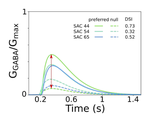CINV Postdoctoral Fellowship: An integrated biophysical network model of motion direction selectivity in the mammalian retina
Detection of motion and motion direction in the visual mammalian system is observed at processing stages as early as the retinal circuitry (Barlow & Levick 1965). Direction-selective ganglion cells (DSGC) in the retina exhibit higher firing activity in response to visual stimuli moving along a preferred direction, and little to none activity for stimuli moving in the opposite direction (Schachter et al. 2010; Jacoby & Schwartz 2016). Several neural mechanisms have been shown to contribute to direction selectivity (DS) in the retina, but the actual contribution of each to the phenomena is yet to be determined. Mathematical models of DS developed with individual cells or cell networks were proposed to understand the effects of the different components of the retinal circuitry, e.g., starburst amacrine cells (SACs) and DSGCs, on DS (Tukker et al. 2004; Enciso et al. 2010; Schachter et al. 2010). However, there is currently no model combining SACs and DSGCs in a network model to analyze the retinal DS system more comprehensibly (Escobar et al. 2013). Our goal was to build a network model of DS in the retina, including SACs and DSGCs, based on wiring connectivity observed in the mammalian retina, and then determine the contribution of each of the components of the network to DS using a wide range of stimulus velocities and amplitudes.
